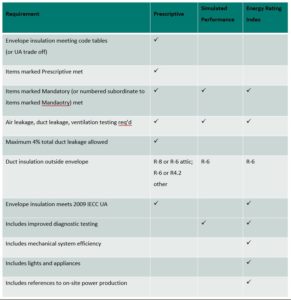
Residential compliance options of the International Energy Conservation Code
![]() One intent, three alternative means of complying with that intent. The intent of the International Energy Conservation Code (IECC) residential provisions is the effective use and conservation of energy over the useful life of the building (IECC Section R101.3), and within the 2015 and 2018 IECC there are three distinct compliance options — typically referred to as the prescriptive, performance and energy rating index (ERI) paths. The code user may consider each of the options and determine which is the best for them. However, one option must be used in its entirety, a user cannot pick different compliance options for different parts of the building. This article provides clarification of the similarities and differences between the three paths and highlights the compliance issues to verify.
One intent, three alternative means of complying with that intent. The intent of the International Energy Conservation Code (IECC) residential provisions is the effective use and conservation of energy over the useful life of the building (IECC Section R101.3), and within the 2015 and 2018 IECC there are three distinct compliance options — typically referred to as the prescriptive, performance and energy rating index (ERI) paths. The code user may consider each of the options and determine which is the best for them. However, one option must be used in its entirety, a user cannot pick different compliance options for different parts of the building. This article provides clarification of the similarities and differences between the three paths and highlights the compliance issues to verify.
Section R401.2 of the IECC identifies three compliance paths or options. They are listed below with their common names.
- Sections R401 through R404 of the IECC (commonly called the prescriptive path).
- Section R405 and the provisions of Sections R401 through R404 of the IECC indicated as “mandatory” (commonly called the performance or simulated performance path).
- The energy rating index approach in IECC Section R406.
Table 1 of the IECC (IECC Compliance Paths) below identifies the components of each compliance path. When conducting a residential plan review or inspection it is critical to know which compliance path was chosen. Not only do the requirements differ, so do the compliance tools.
An essential verification process, applicable to any compliance path, should include verifying:
- The project information matches the information on the building plans.
- The levels of efficiency (insulation, windows and doors) shown on the plans and onsite meet or exceed that shown in the documentation.
- The correct ceiling, wall and floor components that define the building envelope are shown on the plans and onsite.
- Air leakage testing.
- The Manual J or other engineering calculations required in IECC Section R403.7 are provided and match the inputs match values on the plans and in the compliance documentation.
Prescriptive compliance

The prescriptive compliance path requires no software or modeling. It can be verified via a checklist. It requires, quite simply, complying with (as applicable to the building) the provision of IECC Section R401 General, Section R402 Building Thermal Envelope, Section R403 Systems, and Section R404 Electrical Power and Lighting Systems. Using the prescriptive path, one must simply comply with the items listed as prescriptive or mandatory in IECC Sections R401 through R404. This makes the prescriptive code fairly simple to follow. However, it does not give builders credit for any of the additional efficient practices that they may incorporate into their buildings, improved diagnostic testing results, or mechanical systems or domestic appliances that are more efficient than the federal minimums.
Jurisdictions may wish to provide applicants with a prescriptive checklist form tailored to the local climate zone. A checklist form can be used to verify compliance during both plan review and inspection. Verification may be limited to the essentials noted above.
Total UA alternative
Within IECC Section R402 Building Thermal Envelope there is the optional total UA (sum of U-factor times assembly area) alternative — IECC Section R402.1.5 — which offers a tradeoff of lower performance building envelope assemblies with higher performance assemblies. This option only allows for envelope tradeoffs; none for mechanicals, performance testing or anything else. Compliance may be calculated by hand in accordance with the ASHRAE Handbook of Fundamentals, or by using the free United States Department of Energy software RESCheck, which may be downloaded here. When applicants submit with REScheck compliance documentation, a separate form is not needed, the REScheck generated forms will provide the information needed for plan review and inspection. Table 402.1.2 of the IECC is no longer applicable when using the UA alternative. In addition to the essential items listed above, it will be important to verify:
- The project complies with the applicable code. The maximum UA must be greater than or equal to the proposed design UA to demonstrate compliance.
- The gross area or perimeter and window areas values represent the proposed design.
- The correct ceiling, wall and floor components that define the building envelope are shown.
Simulated performance compliance
The performance path, or compliance option, provides code users with greater flexibility through using computer simulation to demonstrate that the proposed design would have the same or less than the same energy as the “standard reference design” building. Section R405 of the IECC details the protocol for demonstrating compliance. As noted in IECC Sections R401.2(2) and R405.2, the proposed design must include all applicable requirements labeled “mandatory” in IECC Sections R402 through R403 — these are design elements that cannot be traded off. Energy for lighting and appliances is not included in this path, and mechanical system efficiency is normalized between the proposed and standard reference designs.
Compliance documentation
Because this compliance option involves complex interactions between the building envelope, fenestration size/location, and diagnostic testing results, compliance calculations must be performed using energy modeling software that meets the requirements of IECC Section R405.6. Examples of such software include REM/rate, Ecotrope and EngergyGuage. Note that RESCheck does not provide the analysis needed for compliance with the simulated performance option.
In addition to the essential verification items listed above, during plan review and inspection, IECC Section R405.4 specifies the documentation requirements for the simulated performance path.
For building permit
-
- Compliance report demonstrating proposed design has less annual energy cost than the standard reference design.
- Worst-case orientation, building configuration and diagnostic testing specs.
For certificate of occupancy
-
- Compliance report showing actual as-built orientation, building configuration and diagnostic testing results.
It will be important to verify:
- The compliance documentation indicates the annual energy cost of the proposed design is less than or equal to the standard reference design.
- The gross area or perimeter and window areas values represent the proposed design.
- The proposed design includes applicable mandatory requirements from IECC Sections R401 through R404.
Energy Rating Index
The Energy Rating Index was introduced as Section R406 of the 2015 IECC. In 2018, the IECC language was simplified by referring to ANSI/RESNET/ICC Standard 301, and other modifications were made, but the scope of the compliance path did not change.
An ERI is a measurement of a residential building’s efficiency based on a comprehensive list of building criteria — such as assembly types, geometry, orientation, solar heat gain coefficient, insulation and efficiency levels, lighting and appliances (including those not addressed in IECC Sections R401 through R405, such as washers and dryers), fans, service water systems, thermal storage, and whole-house mechanical ventilation elements — from the construction documents.
An ERI is calculated comparing a residential building to the standard reference design, which is aligned with the 2006 IECC. Compliance documentation will provide an ERI value typically between 100 and zero. Where the energy performance of the actual building and the ERI reference building are equal, the ERI is 100, and where the actual residential building requires no net purchased energy annually, the ERI is zero.
Table R406.4 of the IECC provides the maximum allowed ERI score based on climate zone. Note, whereas in IECC Section 405 the simulated performance option uses values from construction documents that can be verified in the field, the ERI is not calculated until values have been field verified and appropriate tests are conducted.
These elements are verified in the field, an assessment of insulation installation is conducted, building and duct air leakage is determined, and the gathered information is used to calculate an ERI by comparing the efficiency of this constructed design to an ERI reference design.
In addition to the essential verification items listed above, it will be important to verify:
- The compliance documentation indicates the ERI of the proposed design is less than or equal to that referenced in IECC Table R406.4.
- The building thermal envelope is equal to or greater than the levels of efficiency and solar heat gain coefficient in Tables 402.1.1 or 402.1.3 of the 2009 IECC (or 2015 IECC when on-site renewable contributes to the ERI score).
- The proposed design includes applicable mandatory requirements from IECC Sections R401 through R404.
Knowledge is power
Communicating compliance expectations across the jurisdiction personnel and to applicants will ease plan review and inspection of the IECC. Forms, webinars and newsletters can all be used to effectively communicate expectations and streamline applications. Training and education are available from a wide variety of sources. The International Code Council offers online and locally delivered training and offers free technical support to its members. The Code Council’s online store offers a wide range of IECC-related publications. The Department of Energy has an extensive library of free educational resources and you can download RESCheck and COMCheck, plug and play, and menu-driven compliance tools. Additionally, major industry groups ranging from the American Institute of Architects to heating, ventilation and air conditioning providers offer industry-specific support.








